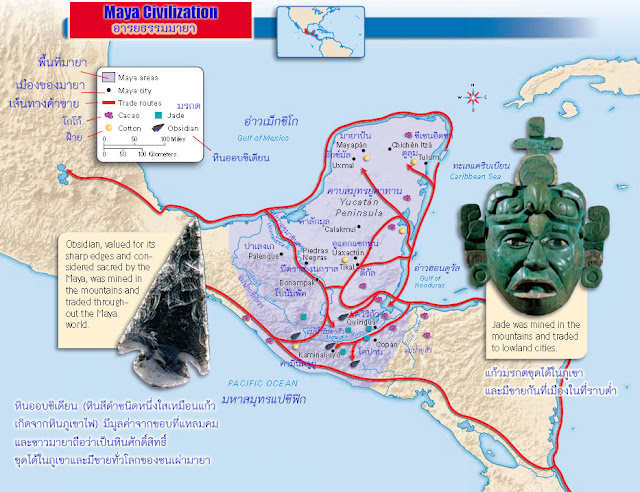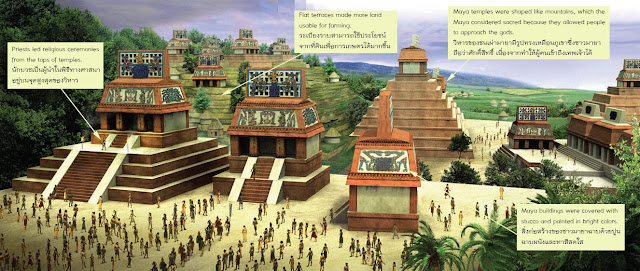The
Maya
Geography and the
Early Maya
The region known as
Mesoamerica stretches from the central area of Mexico
south to the northern part of Central America. It was in this region that a people called the Maya developed a remarkable civilization.
Around 1000 BC the
Maya began settling in the lowlands of what is now
northern Guatemala. Thick tropical forests covered most of the land, but the people cleared areas to farm. They grew a variety of crops, including
beans, squash, avocados, and maize, or corn. The forests provided valuable resources, too. Forest
animals such as deer, rabbits, and monkeys were sources of
food. In addition, trees and other plants made good
building materials. For example,
some Maya used wooden poles and vines, along with mud,
to build their houses.
The early Maya lived in small,
isolated villages. Eventually, though,
these villages started trading with one another and with other
groups in Mesoamerica. As trade increased, the villages grew. By about AD 200, the Maya had
begun to build large cities in Mesoamerica.
|
ชาวมายา
ภูมิศาสตร์และชาวมายายุคแรก
ดินแดนที่เรียกว่า
เมโสอเมริกา ทอดยาวเหยียดตั้งแต่บริเวณตอนกลางของเม็กซิโกใต้ไปจนถึงตอนเหนือของอเมริกากลาง
ณ บริเวณนี้ ผู้คนที่เรียกกันว่า ชาวมายา ได้มีการพัฒนาอารยธรรมอย่างน่าทึ่ง
ประมาณ
1000 ปีก่อนคริสตกาล ชาวมายาเริ่มตั้งรกรากในบริเวณที่ราบซึ่งปัจจุบันคือตอนเหนือของประเทศกัวเตมาลา
ป่าไม้เขตร้อนหนาแน่นปกคลุมดินแดนแห่งนี้เป็นส่วนใหญ่ แต่ผู้คนก็ปรับบริเวณเพื่อทำไร่นา
โดยปลูกพืชพันธุ์ธัญญาหารชนิดต่าง ๆ ประกอบด้วย พืชจำพวกถั่ว พืชตระกูลน้ำเต้า อาโวคาโดและพืชจำพวกข้าวโพด
ป่าไม้ได้จัดสรรทรัพยากรธรรมชาติอันมีคุณค่าให้ด้วย สัตว์ป่า เช่น กวาง กระต่าย
และลิงเป็นแหล่งทรัพยากรอาหาร อีกประการหนึ่ง ต้นไม้ และพืชชนิดอื่น ๆ
เป็นวัสดุสำหรับก่อสร้างได้ดี ยกตัวอย่างเช่น ชาวมายาบางคนใช้เสาไม้และเถาวัลย์ ฉาบด้วยโคลน
เพื่อสร้างเป็นที่อยู่อาศัยของตนเอง
ชาวมายายุคแรกอาศัยอยู่ในหมู่บ้านขนาดเล็กโดดเดี่ยว แม้ว่าในที่สุดหมู่บ้านเหล่านี้จะเริ่มทำการค้าขายกับหมู่บ้านอื่น
ๆ และชนกลุ่มอื่น ๆ ในเมโสอเมริกา เมื่อการค้าขายเจริญขึ้น หมู่บ้านก็เติบโตขึ้น
เมื่อประมาณ ค.ศ. 200 (พ.ศ. 743) ชาวมายาก็เริ่มก่อสร้างเมืองขนาดใหญ่ใน เมโสอเมริกา
|
The Classic Age
The Maya civilization
reached its height between about AD 250 and 900. This time in Maya history is known as
the Classic Age. During this time,
Maya territory grew to include more than 40 large cities.
Maya cities were
really city-states. Each had its own government and its own king. No
single ruler ever united the many cities into one empire. However, trade helped hold Maya
civilization together. People exchanged
goods for products that were not available locally. For example, Maya in the lowlands
exported forest goods, cotton, and cacao beans,
which are used in making chocolate. In
return, they received obsidian (a
glasslike volcanic rock), jade, and
colorful bird feathers.
Through trade, the Maya got supplies for construction. Maya cities had grand buildings, such as palaces decorated with carvings and paintings. The Maya also built stone pyramids topped with temples. Some temples honored local kings. For example, in the city of Palenque, the king Pacal built a temple to record his achievements. In addition to palaces and temples, the Maya built canals and paved large plazas, or open squares, for public gatherings. Farmers used stone walls to shape hillsides into flat terraces so they could grow crops on them. Almost every Maya city also had a stone court for playing a special ball game. Using only their heads, shoulders, or hips, players tried to bounce a heavy, hard rubber ball through stone rings attached high on the court walls. The winners of these games received jewels and clothing. Maya Culture
In Maya society,
people’s everyday lives were
heavily influenced by two main forces. One was the
social structure, and the other was religion.
Social Structure
The king held the
highest position in Maya society. Because
he was believed to be related to the gods, the king had
religious as well as political authority. Priests,
merchants, and noble warriors were also part of the upper class. Together with the
king, they held all the power in Maya society.
Most Maya, though,
belonged to the lower class. This
group was made up of farming families who lived outside
the cities. The women cared for the
children, cooked, made yarn, and wove cloth. The men farmed, hunted, and crafted
tools.
Lower-class
Maya had to “pay” their rulers by giving the rulers part of their crops
and goods such as cloth and salt. They also had to help construct temples and other public
buildings. If their city went to war, Maya
men had to serve in the army, and if captured in battle,
they usually became slaves. Slaves
carried goods along trade routes or worked as servants
or farmers for upper-class Maya.
|
ยุคคลาสสิก
อารยธรรมมายาเจริญถึงจุดสูงสุดในระหว่างประมาณ
ค.ศ. 250 (พ.ศ. 793) ถึง ค.ศ. 900 (พ.ศ. 1443) ช่วงเวลานี้ในประวัติศาสตร์ของชาวมายา
เรียกว่า ยุคคลาสสิก ในช่วงนี้ ดินแดนของชาวมายาเจริญเติบโตจนมีเมืองใหญ่มากกว่า
40 เมือง
เมืองของชาวมายาเป็นนครรัฐอย่างแท้จริง
แต่ละเมืองมีรัฐบาลเป็นของตนเองและมีกษัตริย์เป็นของตนเอง ไม่มีผู้ปกครองคนใดคนหนึ่งเคยรวมหลายเมืองไว้เป็นอาณาจักรเดียวกัน
แต่อย่างไรก็ตาม การค้าขายได้ยึดมั่นอารยธรรมมายาเข้าด้วยกัน ผู้คนได้แลกเปลี่ยนสินค้าที่ตนเองหาไม่ได้ในท้องถิ่น
ยกตัวอย่างเช่น ชาวมายาในที่ราบต่ำจะส่งออกสินค้าป่า ฝ้าย และเมล็ดโกโก้
ที่ใช้ในการทำช็อกโกแลต พวกเขาก็ได้รับหินออบซิเดียน (หินจากภูเขาไฟคล้ายแก้ว) หยก และขนนกสีสดสวยงดงามเป็นการตอบแทน
ชาวมายาได้รับวัสดุก่อสร้างจากการค้าขาย
เมืองของชาวมายามีสิ่งก่อสร้างใหญ่โต เช่น
ปราสาทที่ประดับประดาด้วยการแกะสลักและภาพจิตรกรรม ชาวมายายังได้สร้างพีระมิดหินมียอดเป็นวิหาร
วิหารบางแห่งแสดงถึงเกียรติยศของกษัตริย์ท้องถิ่น ยกตัวอย่างเช่น ในเมืองปาเลงเก
กษัตริย์ปากัลป์ได้สร้างวิหารเพื่อบันทึกความสำเร็จของพระองค์
นอกจากปราสาทและวิหารแล้ว
ชาวมายาก็ได้สร้างคลองและปูพื้นลานกว้างสาธารณะขนาดใหญ่ให้ประชาชนมาชุมนุมกัน ชาวนาใช้กำแพงหินทำไหล่เขาเป็นระเบียงราบเพื่อให้สามารถปลูกพืชพันธุ์ธัญญาหารบนระเบียงเหล่านั้นได้
เมืองของชาวมายาเกือบทุกเมืองยังใช้ลานหินสำหรับเล่นเกมลูกบอลพิเศษ ผู้เล่นจะพยายามใช้ศีรษะ
ไหล่ หรือสะโพกเท่านั้นเดาะลูกบอลที่เป็นยาง หนัก แข็ง ให้ผ่านห่วงหินที่ติดอยู่ที่สูงบนผนังสนาม ผู้ชนะในเกมนี้จะได้รับเพชรพลอยและเสื้อผ้าอาภรณ์
วัฒนธรรมของชาวมายา
ในสังคมของชาวมายา
พลังอำนาจหลัก 2 ประการ ที่มีอิทธิพลอันเข้มแข็งต่อการดำเนินชีวิตประจำวันของผู้คน
คือ โครงสร้างทางสังคมอย่างหนึ่ง ศาสนาอย่างหนึ่ง
โครงสร้างทางสังคม
กษัตริย์มีตำแหน่งสูงสุดในสังคมมายา
เนื่องจากมีความเชื่อกันว่ากษัตริย์เกี่ยวข้องกับพระเจ้า กษัตริย์มีอำนาจในทางศาสนาและทางการเมืองด้วย
นักบวช พ่อค้า และนักรบผู้สูงศักดิ์ ก็เป็นส่วนหนึ่งของชนชั้นสูงด้วย คนเหล่านั้นกุมอำนาจทั้งหมดในสังคมของชาวมายาร่วมกับกษัตริย์
แม้ว่าชาวมายาส่วนใหญ่จะอยู่ในชนชั้นต่ำ
ชนกลุ่มนี้รวมกันเป็นครอบครัวเกษตรกรที่อาศัยอยู่นอกเมือง เหล่าสตรีจะดูแลเลี้ยงดูบุตร
หุงหาอาหาร ปั่นเส้นด้าย และทอเสื้อผ้า เหล่าบุรุษจะทำการเกษตร ล่าสัตว์
และประดิษฐ์เครื่องมือ
ชาวมายาที่เป็นชนชั้นต่ำ
จะต้องจ่ายค่าตอบแทนให้กับผู้ปกครองด้วยการประทานพืชพันธุ์ธัญญาหารและผลิตภัณฑ์
เช่น เสื้อผ้าและเกลือบางส่วนให้กับผู้ปกครอง นอกจากนั้น
พวกเขายังช่วยสร้างวิหารและสิ่งก่อสร้างสาธารณะอื่น ๆ ถ้าเมืองของพวกเขาเข้าสู่สงคราม
บุรุษชาวมายาจะต้องเข้ารับใช้กองทัพ และถ้าเมืองถูกยึดในสงคราม
ปกติพวกเขาจะกลายเป็นทาส ทาสจะขนสินค้าไปตามเส้นทางการค้าขายหรือทำงานเป็นผู้รับใช้หรือเป็นเกษตรให้กับชาวมายาที่อยู่ในสังคมชั้นสูง
|
Palenque
The ancient Maya city
of Palenque was a major power on the border between the Maya highlands and lowlands. Its great temples and plazas were typical of the Classic
Age of Maya civilization.
|
เมืองปาเลงเก
เมืองปาเลงเกของชนเผ่ามายาโบราณเป็นเมืองสำคัญที่มีชายแดนระหว่างที่ราบสูงและที่ราบต่ำของชนเผ่ามายา
วิหารอันยิ่งใหญ่และลานกว้างสาธารณะเป็นแบบฉบับของยุคคลาสสิกแห่งอารยธรรมายา
|
Religion
The Maya worshipped
many gods, including a creator, a sun god, a moon
goddess, and a maize god. Each god
was believed to control a different aspect of daily life.
According to Maya
beliefs, the gods could be helpful or harmful, so people
tried to please the gods to get their help.
The Maya believed their gods needed blood to prevent disasters or the end of the world. Every
person offered blood to the gods by piercing their
tongue or skin. On special occasions,
the Maya also made human sacrifices. They
usually used prisoners captured in battle, offering
their hearts to stone carvings of the gods.
Achievements
The Maya’s religious beliefs led them to make
impressive advances in science. They built
observatories, or buildings from which people
could study the sky, so their priests could watch the
stars and plan the best times for religious festivals. With the knowledge they gained about
astronomy, the Maya developed two calendars. One, with 365 days, guided planting,
harvesting, and other farming activities. This
calendar was more accurate than the calendar used in Europe at that time. The Maya
also had a separate 260-day
calendar that they used for keeping track of religious
events.
The Maya could
measure time accurately partly because they were skilled mathematicians. They created a number system that helped them make complex calculations,
and they were among the first people with a symbol for
zero. The Maya used their number
system to record key dates in their history.
The Maya also
developed a writing system. In a way, it was similar to
Egyptian hieroglyphics, because symbols represented both objects and sounds. The Maya carved series of these symbols into large stone tablets to record their history and the achievements of
their kings. They also wrote in bark
paper books and passed down stories and poems orally.
The Maya created
amazing art and architecture as well. Maya
jade and gold jewelry was exceptional. Also,
their huge temple-pyramids were
masterfully built. The Maya had neither metal tools for
cutting nor wheeled vehicles for carrying supplies. Instead, workers used obsidian tools to
cut limestone into blocks. Then workers rolled
the giant blocks over logs and lifted them with ropes. The Maya often decorated their
buildings with paintings.
|
ศาสนา
ชาวมายาเคารพนับถือเทพเจ้าหลายองค์
ประกอบด้วย พระผู้สร้าง สุริยเทพ (เทพประจำพระอาทิตย์) จันทราเทวี
(เทพีประจำพระจันทร์) และเทพแห่งข้าวโพด (เทพแห่งพืชพันธุ์ธัญญาหาร) เชื่อกันว่า
เทพแต่ละองค์จะควบคุมดูแลด้านต่าง ๆ ของชีวิตประจำวัน
ตามความเชื่อของชาวมายา
เทพเจ้ามีทั้งให้ความช่วยเหลือและก่อให้เกิดภัยพิบัติ ดังนั้น
พวกเขาจึงพยายามทำให้เทพเจ้าโปรดปรานเพื่อจะช่วยเหลือพวกเขา ชาวมายาเชื่อว่า
เทพเจ้าต้องการโลหิตเพื่อป้องกันภัยพิบัติหรืออวสานของโลก ทุก ๆ
คนจึงถวายโลหิตแก่เทพเจ้า ด้วยการแทงลิ้นหรือผิวหนังของตนเอง ในโอกาสพิเศษ
ชาวมายายังได้ประกอบพิธีบูชายัญด้วย ปกติพวกเขาจะใช้นักโทษที่ยึดมาได้ในการทำสงคราม
โดยเอาหัวใจของนักโทษเหล่านั้นวางบนแท่นหินแกะสลักรูปเทพเจ้า
ความสำเร็จ
ความเชื่อทางศาสนาของชาวมายานำไปสู่ความก้าวหน้าในด้านวิทยาศาสตร์อย่างน่าทึ่ง
พวกเขาได้สร้างหอสังเกตการณ์ หรืออาคารที่ผู้คนสามารถมาศึกษาท้องฟ้าได้ ดังนั้น นักบวชของชาวมายาจึงสามารถดูดาวแล้วเอามาวางแผนช่วงเวลาที่ดีที่สุดให้เป็นเทศกาลทางศาสนา
ด้วยความรู้นั้น พวกเขาจึงมีความหน้าด้านดาราศาสตร์ ชาวมายาจึงได้พัฒนาปฏิทิน 2
แบบ คือ แบบหนึ่ง มี 365 วัน เพื่อเป็นแนวทางการเพาะปลูก การเก็บเกี่ยว
และกิจกรรมการเกษตรอื่น ๆ ปฏิทินนี้มีความถูกต้องแม่นยำมากกว่าปฏิทินที่ใช้อยู่ในทวีปยุโรปในเวลานั้น
อีกแบบหนึ่ง คือ ปฏิทินที่มี 260
ที่พวกเขาใช้สำหรับคอยติดตามเหตุการณ์ทางศาสนา
ชาวมายาสามารถวัดเวลาได้ถูกต้องแม่นยำเป็นบางส่วน
เนื่องจากพวกเขาเป็นนักคณิตศาสตร์ผู้มีความชำนาญ พวกเขาได้สร่างระบบการนับที่ช่วยให้การนับสลับซับซ้อนขึ้น
และพวกเขาเป็นคนกลุ่มแรกกลุ่มหนึ่งที่มีสัญลักษณ์เลข 0 ชาวมายาได้ใช้ระบบการนับของพวกเขาในการบันทึกวันเวลาที่สำคัญในประวัติศาสตร์
ชาวมายายังได้พัฒนาระบบการเขียนด้วย
คล้ายกับอักษรรูปลิ่มของอียิปต์อยู่บ้าง เนื่องจากสัญลักษณ์ใช้แทนวัตถุและเสียง ชาวมายาได้สลักสัญลักษณ์เหล่านี้เป็นชุด
ๆ ลงในบนแผ่นหินขนาดใหญ่เพื่อบันทึกประวัติศาสตร์ของตนเองและความสำเร็จของกษัตริย์ของพวกเขา พวกเขายังได้เขียนลงในสมุดกระดาษเปลือกไม้และสืบทอดเรื่องราวและบทกวีด้วยการท่องจำ
ชาวมายาได้สร้างศิลปะและสถาปัตยกรรมอันน่าทึ่งด้วย
หยกและเครื่องทองรูปพรรณของชาวมายาก็มีความยอดเยี่ยม อีกประการหนึ่ง
พีระมิดที่เป็นวิหารขนาดมหึมาถูกสร้างขึ้นอย่างเชี่ยวชาญ ชาวมายาไม่มีเครื่องมือโลหะสำหรับตัดหรือยานพาหนะสำหรับขนส่งเสบียงอาหาร
คนงานใช้เครื่องที่ทำจากหินออบซิเดียน (หินสีดำชนิดหนึ่งใสเหมือนแก้วเกิดจากหินภูเขาไฟ) เพื่อตัดหินปูนเป็นก้อนอิฐใหญ่ แล้วคนงานก็กลิ้งก้อนอิฐขนาดใหญ่นั้นไปบนท่อนซุงและเอาเชือกยกขึ้น
ปกติแล้วชาวมายาจะวาดภาพจิตรกรรมประดับตกแต่งอาคารของพวกเขา
|
ภาพนี้ (ซ้ายมือ) เป็นหอสังเกตการณ์ที่เมืองชีเชนอิตซาของชนเผ่ามายา
หินสลัก (ขวามือ) คือศิลปะและการเขียนบันทึกพิธีกรรมทางศาสนา
Decline of Maya
Civilization
Maya civilization
began to collapse in the AD 900s. People
stopped building temples and other structures. They left the cities and moved back to
the countryside. What caused this
collapse? Historians aren’t sure, but
they think a combination of factors was probably
responsible.
One factor could have
been the burden on the common people. Maya
kings forced their subjects to farm for them or work on building projects. Perhaps people didn’t want to work for the kings. They might have decided to rebel
against their rulers’ demands and abandon their cities.
Increased warfare
between cities could also have caused the decline. Maya cities had always fought for power. But if battles became more widespread
or destructive, they would have cost many lives and
disrupted trade. People might have
fled the cities for their safety.
A related theory is
that perhaps the Maya could not produce enough to feed everyone. Growing the same crops year after year could have weakened the soil. In
addition, as the population grew, the demand for food
would have increased. To meet this
demand, cities might have begun competing fiercely for
new farmland. But the resulting
battles would have ruined more crops, damaged more land,
and created even greater food shortages.
Climate change could
have played a role, too. Scientists
know that Mesoamerica suffered from droughts during the
period when the Maya were leaving their cities. Droughts would have made it hard to grow enough
food for city dwellers.
Whatever the reasons,
the collapse of Maya civilization happened gradually. The Maya scattered after 900, but they did not
disappear entirely. In fact, the Maya civilization
later revived in the Yucatán Peninsula. But by the time Spanish conquerors reached
the Americas in the 1500s, Maya power had faded.
|
การล่มสลายของอารยธรรมมายา
อารยธรรมของชาวมายาเริ่มล่มสลายในคริสต์ศตวรรษที่
900 ผู้คนได้หยุดก่อสร้างวิหารและสิ่งก่อสร้างอื่น ๆ พวกเขาทิ้งเมืองและอพยพกลับไปยังชนบท
การล่มสลายนี้เกิดจากสาเหตุใด? นักประวัติศาสตร์ก็ไม่แน่ใจ แต่พวกเขาคิดว่า
อาจจะเกิดจากปัจจัยหลายอย่างรวมกัน
ปัจจัยน่าจะเกิดจากคนทั่วไปมีภาระหนัก
กษัตริย์ของมายาบังคับให้ราษฎรทำเกษตรกรรมให้กับตนเองหรือทำงานในโครงการก่อสร้างหลายอย่าง
บางที ราษฎรไม่ต้องการทำงานให้กับกษัตริย์ พวกเขาอาจจะตัดสินใจต่อต้านความประสงค์ของนักปกครองและละทิ้งเมืองของตนเองไป
สงครามระหว่างเมืองเพิ่มมากขึ้น
อาจจะเป็นสาเหตุให้เกิดการล่มสลาย
เมืองของชาวมายาต่อสู้กันเพื่อแย่งอำนาจอยู่เสมอ แต่ถ้าสงครามขยายหรือก่อความเสียหายมากขึ้น
จะทำลายชีวิตคนที่มีค่าจำนวนมากและทำให้การค้าขายเกิดความยุ่งเหยิง ประชาชนอาจจะหนีออกจากเมืองเพื่อหาที่ปลอดภัย
มีทฤษฎีที่เกี่ยวข้องอย่างหนึ่งคือบางทีชาวมายาอาจจะไม่สามารถผลิตอาหารได้เพียงพอที่จะหล่อเลี้ยงทุก
ๆ คนได้ การปลูกพืชพันธุ์ธัญญาหารที่เหมือนกันทุก ๆ ปี อาจทำให้ดินทรุดโทรม อีกประการหนึ่ง
เมื่อประชากรเพิ่มมากขึ้น ความต้องการอาหารอาจจะเพิ่มขึ้น ชาวเมืองอาจจะเริ่มแข่งขันกันหาที่ทำกินใหม่
ๆ อย่างเข้มข้น เพื่อสนองความต้องการนี้ แต่ผลจากการก่อสงครามอาจจะทำลายพืชพันธุ์ธัญญาหารมากขึ้น
ๆ ทำลายที่ดินทำกินมากขึ้น ๆ
และแม้กระทั่งสร้างความขาดแคลนอาหารอย่างใหญ่หลวงมากขึ้น
การเปลี่ยนแปลงด้านสภาอากาศน่าจะมีบทบาทด้วย
นักวิทยาศาสตร์ทราบว่า ดินแดนเมโสอเมริกาได้รับความทุกข์จากความแห้งแล้งในช่วงเวลาที่ชาวมายาอพยพออกจากเมือง
ความแห้งแล้งน่าจะสร้างความยากลำบากในการเพาะปลูกอาหารให้เพียงต่อประชากรชาวเมือง
ไม่ว่าเหตุผลใดก็ตาม
การล่มสลายของอารยธรรมมายาเกิดขึ้นทีละน้อย ๆ ชาวมายาแตกกระจัดกระจายหลังจาก
ค.ศ. 900 (พ.ศ. 1443) แต่พวกเขาไม่ได้หายสาบสูญอย่างสิ้นเชิง ตามความเป็นจริง
อารยธรรมมายายังคงมีอยู่ต่อมาในคาบสมุทรยูกาตัง
แต่เป็นช่วงเวลาที่ผู้พิชิตชาวสเปนได้เดินทางมาถึงอเมริกาในทศวรรษที่ 1500
อำนาจของชาวมายาจึงหายไป
|
Pacal (603–683)
Pacal became king of
the Maya city of Palenque when he was just
12 years old. As king, Pacal led
many important community events, such as religious
dances and public meetings. When he died he was buried
at the bottom of the Temple of the Inscriptions shown to
the near left.
|
ปากัล (ค.ศ. 603–683
= พ.ศ. 1146 – 1226 อายุ
80 ปี)
ปากัลเป็นกษัตริย์ของเมืองปาเลงเกแห่งเผ่ามายาในขณะที่อายุเพียง
12 ปี ขณะเป็นกษัตริย์ ปากัลได้เป็นผู้นำเหตุกาณ์ทางสังคมที่สำคัญหลายครั้ง เช่น
การร่ายรำทางศาสนาและการประชุมสาธารณะ เมื่อท่านสิ้นชีวิตก็ได้รับการฝังพระศพไว้ใต้ฐานวิหารมีอักษรจารึกไว้ใกล้
ๆ ทางด้านซ้าย
|




